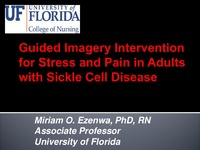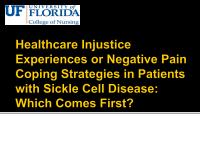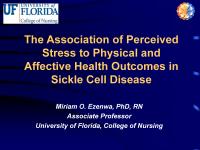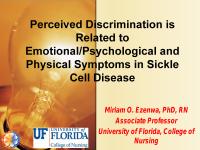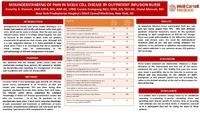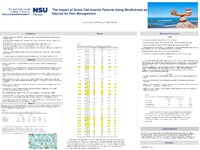| dc.description.abstract | <p>Session presented on Monday, July 27, 2015:</p>
<p><strong>Purpose:</strong> Pain, the hallmark symptom of sickle cell disease (SCD) affects the quality of life and productivity of those with it. Stress is a known trigger for the acute pain crisis of SCD. Little is known about the effects or mechanisms of stress-reduction treatment in adults with SCD. Adding guided imagery (GI) as a supplement to analgesic therapies will address the dearth of cognitive-behavioral strategies for controlling SCD pain. Guided by the hypothalamic-pituitary-adrenal (HPA) axis theory, the purpose of this pilot study was to test the feasibility of a GI stress reduction intervention protocol in adults with SCD who report that stress is a trigger for starting or intensifying their pain. The HPA theory posits that stress is associated with over-activation of neurotransmitters and hormones (e.g., cortisol, norepinephrine, and epinephrine) that cause flight-or-fight responses and intensify responses to pain. Therefore, GI is expected to reduce self-reported stress and pain and cortisol will serve as a biomarker of the physiological response underpinning the self reports.</p>
<p><strong>Methods:</strong> Randomized to GI or control groups, patients (N=21, mean age 30+/-8 years [21-47], 95% African American, 67% female) participated in pre-post clinical trial. At baseline patients completed the valid and reliable PAINReportIt, which includes questions to measure patients' demographics. Patients completed current stress and current pain measures. They provided swab derived saliva samples for baseline cortisol measurements. The GI group was instructed to view a 12 min GI video after pretest measures via a Galaxy Internally-enabled tablet. For example, the GI video clips focus on 'breathing out worry, breathing in light' and guide the patients to 'Notice the cloud-like formations on the screen.' Patients viewed colorful smoke-like images that slowly changed shapes against a dark background (images, therefore, do not represent any concept with potential negative connotations), listened to soothing female voice, and followed slow-paced guided imagery instructions. The control group was instructed to record their sickle cell experience on the tablet for 12 min to control for attention. The audio-taped questions were self-administered and had onscreen directions (click to hear the next question) and patients' responses were automatically captured via the computer microphone. After intervention per group assignment, patients provided swab derived saliva samples for cortisol measurements at 0 min and 30 mins. We analyzed the data using multi-level regression analysis to determine the effects of GI on current stress, current pain, and cortisol concentrations. Salivary cortisol was measured in duplicate by enzyme-linked immunosorbent assay (ELISA).</p>
<p><strong>Results:</strong> We found that 100% (n=21) of consented patients actually participated and completed the study, 100% of the PAINReportIt and other questionnaire items were completed, and 100% reported that they liked the intervention. There was a statistically significant effect of GI on stress (p<.01) and a trend for positive effects of GI on pain (p=.22). As figure 1 shows, the effects of GI on cortisol concentrations, current stress, and current pain indicate that the GI group scores improved more than the control group following the intervention compared to the control group. Cortisol concentrations varied considerably in this small sample and despite random assignment to groups, the GI group had considerably higher concentrations at baseline.</p>
<p><strong>Conclusion:</strong> The study protocol was feasible in this vulnerable population. Based on these results, we are able to determine the effect size for the GI intervention and calculate the sample size needed to conduct an efficacy trial of GI intervention using this protocol in adults with SCD and to extend it to a longer-term study with patient using the mobile GI anywhere and anytime they encounter stressful situations. Findings from this promising feasibility study show that patients kept the scheduled study appointments and completed a simple and cost-effective trial of GI intervention on the mobile tablet device; the GI intervention reduced the impact of stress on SCD pain. Findings thus far are consistent with the HPA axis theory and support our hypothesis that a single 12-min GI intervention session is sufficient to reduce current stress and pain. Consequently, GI could be used to control pain during emergency department and acute care center visits while patients are waiting to be evaluated for further pain management. Findings have potential to inform cognitive-behavioral strategies for stress and pain reduction in this vulnerable population. >1. De D. Sickle cell anaemia 1: background, causes and incidence in the UK. Br J Nurs. 2005 Apr 28-May 11;14(8):447-50. 2. Serjeant GR, Ceulaer CD, Lethbridge R, Morris J, Singhal A, Thomas PW. The painful crisis of homozygous sickle cell disease: clinical features. Br J Haematol. 1994 Jul;87(3):586-91. 3. Wilkie DJ, Judge MK, Berry DL, Dell J, Zong S, Gilespie R. Usability of a computerized PAINReportIt in the general public with pain and people with cancer pain. J Pain Symptom Manage. 2003 Mar;25(3):213-24. 4. 'Wilkie DJ, Molokie R, Boyd-Seal D, Suarez ML, Kim YO, Zong S, et al. Patient-reported outcomes: descriptors of nociceptive and neuropathic pain and barriers to effective pain management in adult outpatients with sickle cell disease. J Natl Med Assoc. 2010 Jan;102(1):18-27. 5. Melzack R. The McGill Pain Questionnaire: major properties and scoring methods. Pain. 1975 Sep;1(3):277-99. 6. Enzyme-linked immunosorbent assay (ELISA) Salimetrics, State College, PA.</p> | en |
